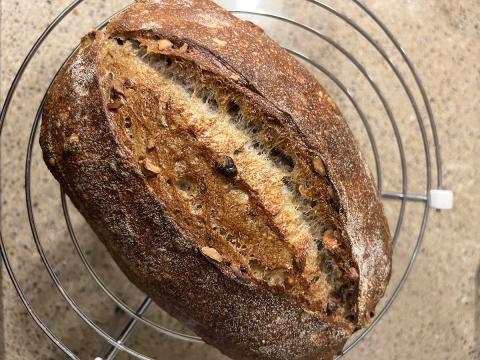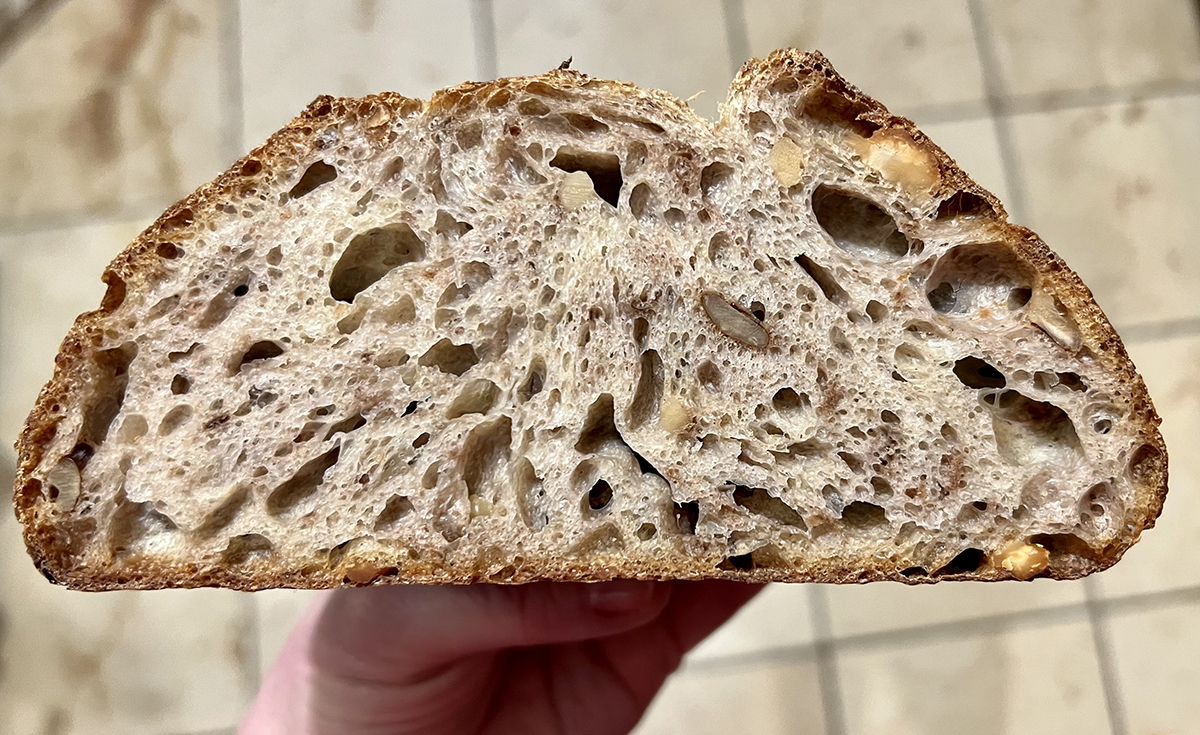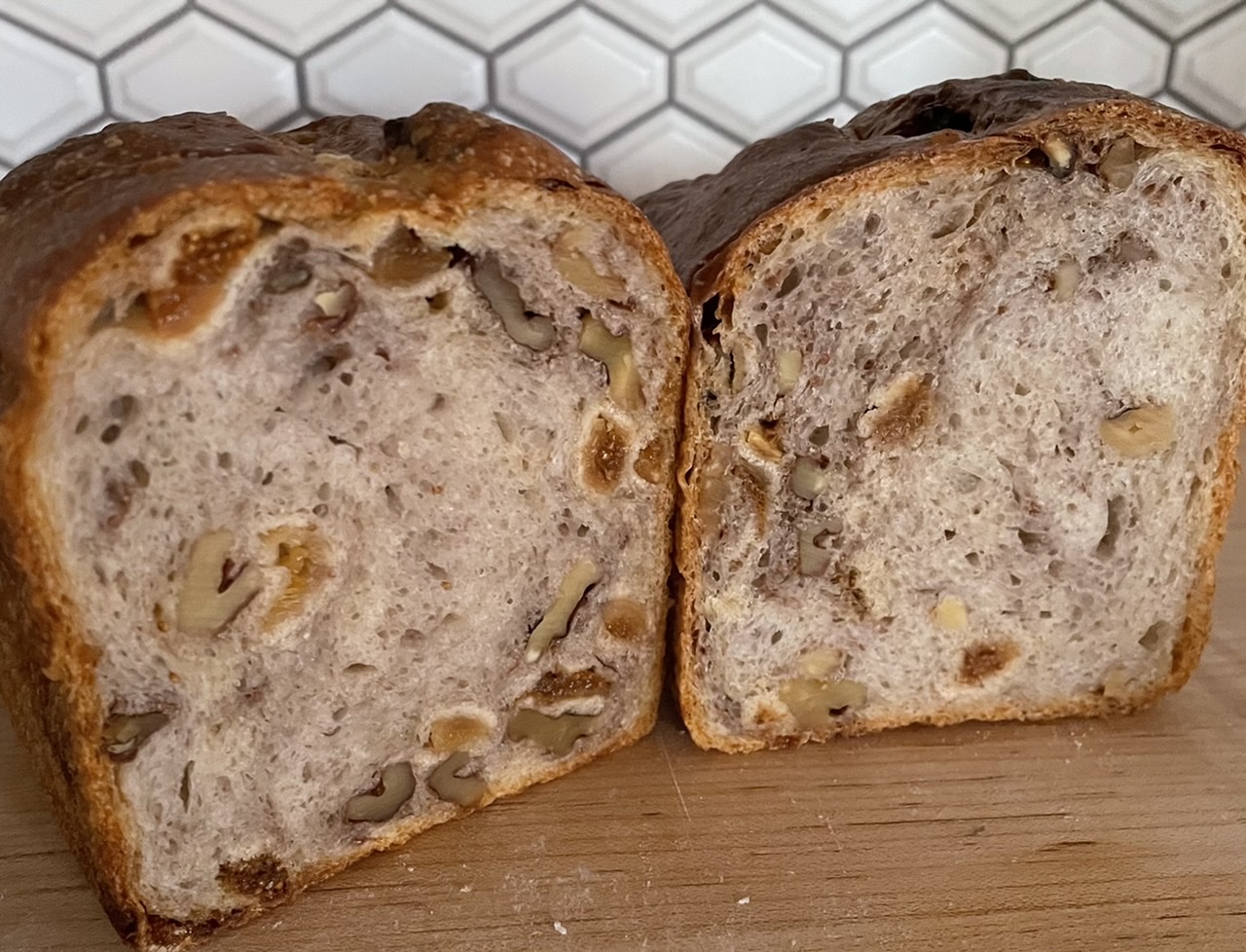
Swiss Farm Bread version 0.5

My husband isn’t a big sourdough fan, so I will occasionally fiddle around with ways to minimize the acidity in our bread. Recently, I was thumbing through the second edition of Hamelman's Bread and was intrigued by his introduction to the formula for Swiss Farm Bread, in which he notes a lack of acidity. I decided to give it a try.
The bread is started with yeast produced from a raisin soak, which was to be a new experience for me. When I ran into trouble, I consulted TFL and found a community bake dedicated to this very bread. Without going into the details all over again (my experience making YW is posted in the Swiss Farm Bread Yeast Water CB), suffice it to say that with a little help from the TFL brain trust, I was eventually successful in starting a yeast water made with apples. By that time, unfortunately, my schedule would not permit a bake for at least a week and I did not want to wait that long. I had Tuesday mostly free, but my free time would be punctuated by interruptions. And with two levain builds, the first of which could reportedly run long, I knew Tuesday probably didn’t have enough hours to give this bread its due. Still, if the dough progressed roughly according to the timelines outlined in the book, I thought I might be able to make it kinda, sorta work. And besides all that, I had an itch to make this bread and was determined to scratch it.
As it played out, the dough did not conform to the time estimates in the book, but that is probably because my day didn’t work out as planned. I ended up stopping Build 2 a little short (it tripled in volume, but I didn’t feel it had peaked), but due to a schedule change, I felt compelled to hope 200% growth would be sufficient. It wasn’t, and the bulk progressed very slowly. I ended up calling the bulk after 5 hours when the dough had risen maybe 30% percent and still looked and felt rather dense. Then I had to leave the house for a few hours, so I refrigerated the shaped loaf. When I returned, there was some slight drying around the edges so I dabbed a bit of water on the dry spots to remoisten them. This of course caused the dough to stick like glue when I tried to turn it out of the banneton. (I know, I know…)
So. Not exactly a text book bake, but I pretty much always screw up something. And I knew this one wouldn’t be textbook before I even started. But I satisfied my urge to try a yeast water bread and now have some idea of what to expect when I can bake this interesting bread with time on my side. I have a not perfect but certainly enjoyable bread to show for my efforts. And next time, I'll know to add the fruit.



Comments
Simply Gorgeous.
You elaborate on your problems time wise but one would not know by looking at your gorgeous result! So glad the YW worked for you. Please do be less worried about your YW and refreshes . Mine is still going strong without any refresh. The orange peel is definitely a game changer, don’t know why I stopped using it but won’t make that mistake again. c
Lovely result!
Hope you end up keeping the YW in the fridge, maintenance of it is quite simple and easy.
Very beautiful result!
Oh my gosh! Thanks, everyone, for the great reviews. It's so encouraging! Trailrunner is correct, of course: Once I ended the second build sooner than desired, it was like dominoes falling. I can't help but wonder what the bread would have looked like if it hadn't stuck to the banneton. Are the holes pointing every which way due to "reconstruction" or was it a shaping error? Shaping is a weak area for me. Anyway, I plan to make this formula again very soon and will try to give the dough all the time it needs.
The yeast water has been in the fridge for a week now. Because I'm new with it and don't see any bubbling, I worry that it's failing, but I'll get over that with experience. I bought an orange a few days ago but then realized it wasn't organic so I need to get an organic one. This has been fun and I'm looking forward to doing more work with YW, but I need to get this bread down pat before moving to the next level. Thank you all again for the help and encouragement.
–AG
Nice loaf AG, Good color on the crust and the glossy crumb is very nice with the purple from the walnuts. My few attempts at YW breads have all risen well but the flavor was somewhat bland, lacking the sour note. The bread does keep very well and the flavor became a bit more pronounced in the last few slices of toast. The two stage build does create some scheduling dilemmas but all in all it is a pretty forgiving dough.
Thanks, Don, I appreciate it. Agreed on the subtle taste, at least initially, but the flavor seems to become more nuanced day by day. It's a nice breakfast loaf. Next time I'll add dried fruit, which I omitted this time, because it needs some tartness. Ultimately, my goal is to try YW in combination with sourdough to see what qualities they bring out in each other. Most of the people I bake for enjoy sourdough (unless it contains enough whole wheat flour to move it out of the "white bread" category), but my husband in particular does not, so I'm always looking for ways to temper the acidity. The never ending quest to make everybody happy, you know? ha!
Including me. Trying to bake something that everyone likes is a difficult task.

Dried fruit is a natural compliment to YW bread to give it a flavor boost. My recent bake was a chopped fig and walnut. That could have been better if I had let the mixer run a little longer when I added the chunks.
If you want another option to tame the sour you should look into the Sweet stiff levain that has popped up around here. It works really well in WW bread.
Don
Benny gave me a heads up on sweet stiff starter too. I actually made one a while back specifically for use in WW but haven't had a chance to use it yet. Gotta change that.
This place is full of great ideas. Like figs.
It won’t necessarily be bubbling so that’s one thing . Another is to make a preferment with some of the flour called for in any bread formula that you want to use YW in. That would be ALL bread formulas for me 😊. For this particular formula of Swiss Farmhouse take a 1/2 c of flour or even a full cup and measure out enough YW to make a 100% hydration preferment. Let it fully develop and then throw it into your bread when you are ready to make your dough.
It never hurts a formula to subtract that much flour and water/ liquid to boost your bread with a YW preferment. The other thing to keep in mind is that once that preferment matures the YW has “ magical” properties and it won’t fall back like SD does so you have almost no constraints on when you have to use it 24 h easily it will sit there and if you cover it and refrigerate it that preferment will hang on for you for several days .
You can proceed with the rest of the formula as you will extra YW never hurts. Hope this helps as far as judging your YW viability. If the preferment doesn’t develop then just like with a test of your dry yeast to see if it’s viable you can know whether your YW needs a boost/ refresh. c
Trailrunner, you have been such a help and so encouraging! Thank you. The Swiss Farmhouse Bread (oops, I got the name wrong, too! hahah) calls for two levains and JonJ also mentioned sticking with that unless I get really comfortable with the strength of the YW. I will definitely do that, because I'm rarely super comfortable with anything during a bake. I'm a belt-and-suspenders kind of gal, for sure. That's probably why I always mess something up, because I'm trying to keep track of too many details. Jon also mentioned about the levain not breaking down when you use YW. Now THAT is magical! I think I'm going to enjoy getting to know this stuff and understanding more about its peculiarities and potential.
AG there are no signs of any screw ups in your bread that I can see. I just see a beautiful loaf of Swiss Farmhouse bread that is well fermented and well baked. You should definitely be proud. Take it from someone who usually has at least one oops during each bake, your bake is awesome.
Another tool to try for non sour sourdough is the stiff sweet levain that I’ve been extolling the virtues of on TFL! They do not make the bread sweet unless you want them to be, but they will not be sour.
Benny
You know what Benny, I've got a jar of leftover sweet stiff levain that I put into the fridge after my last Hokkaido, and even though it is now a week old it still has plenty of power and I've started two (or three ?) new levains from it. It just lasts and lasts!
This for sure. Always takes me awhile to get up to speed on new stuff.
Wow that is incredible Jon, I haven't done that yet, I've always used the stiff sweet levain at peak. It's great to know it has staying power in the fridge! Thanks for the update.
Benny
Is there an amount of the sweet stiff levain that you would suggest for “X” amount of flour? And what’s the formula for this levain? Can I use any flour ? Thank you. c
we’ve gotten in 100 mi so far this week on our bikes! To and from the Y and just messing around. Weather has been great but boy the headwinds! Always nice though to glide back to the house 😂😬
Caroline, I haven't tested the boundaries yet of the sugar concentration, but it is the sugar concentration that is important. I have had excellent results using either brown or white sugar (white having more sugar in it and less water) when the sugar concentration is 52% or greater that is sugar in grams divided by total water in the levain including the water in the starter used to make the levain. So for example I'm making a 100% semolina bread today and the Overnight levain I made was as follows, 14 g starter (100% hydration) + 14 g brown sugar + 18 g water + 41 g semola rimacinata. So total water is 25 g so 14/25 = 56%. I've done with everything from all bread flour, to this semola rimacinata to 100% whole wheat or 100% whole spelt. It always works and it seems that Jon and Don have had some success with it as well.
It is nice to have different options when wanting to bake a non sour naturally leavened bread!
Edited to add:
I will vary the % pre-fermented flour depending on the bake. For super enriched doughs such as the 50:50 sourdough whole wheat brioche I baked last week I boosted the pre-fermented flour up to 14% but have also gone lower to 9% with lean doughs such as the black sesame 100% whole wheat sourdough I also did last week.
Benny.
I knew this bake was going to be a compromise because I didn't have enough time to follow the script. Basically, I dialed up the heat on Brod & Taylor and winged it. To hear your compliments is really encouraging because all of your bakes are very inspiring. You bake with intention and it shows.
So. About that sweet stiff starter.
You might recall that I took a run at your 100% WW Hokkaido Sourdough over at Breadtopia and it didn't rise. I am certain it was because my rye starter wasn't happy about all the enrichments. I then tried gradually converting a piece of it into a sweet stiff starter, but the bread only rose modestly and had more tang than we liked, undoubtedly because the bulk dragged on too long. That wasn't the first time I got poor rises after trying to convert my rye starter and it led me to think I needed to make a new starter from scratch, which I then did. And because I didn't want to encounter any "weak yeast" problems, I nursed it along for over a month. I planned to give your bread another try, but then a whole bunch of other breads needed to happen... crusty sourdough for beef bourguinon at my brother's house, deli rye for the St Pat's Day corned beef, babka for brunch at a friend's... you get the picture. Then I spotted the Swiss Farmhouse formula and spent a couple weeks on yeast water. All the while, I have been maintaining the sweet stiff starter but still haven't baked with it! And I keep thinking about that gorgeous 100% whole wheat loaf.
I'm pretty excited that you've found some success using sweet stiff starter to "tame the tang" in other breads as well. Thanks for calling that to my attention. Since I already have the starter made, it will be easy to use it in my "acid management" experiments. (Hopefully it will be a nice strong starter!)
–AG
Thank you for your comments on my bakes AG, I really appreciate that.
In case it isn’t clear my starter is kept 100% hydration whole rye and no sugar added. I have and use only this starter to build all my levains, stiff, stiff sweet and 100% hydration or higher. I ensure that I feed my starter once per week and after fully peaking it goes back into the fridge until it is needed to make a levain and then fed again after 1 week or when I’m down to 5 g or so and need to feed it.
If your starter isn’t strong, it will have a hard time making an active stiff sweet levain. The conditions are challenging with the low hydration and the high osmotic pressure of the sugar and if it doesn’t start out with a good population of yeast the levain will take a long time to rise and may not be vigorous.
Benny
Sorry AG for the posts that aren't related to your lovely loaf. Benny
We have gotten off base...I too am sorry AG!! It seems that when the topics overlap it is easy to get an answer right then and there rather than try to start a new topic. But like with the YW the info is spread everywhere and it hard to access. Thank you Bennie. I shall cut/paste your info so I don't lose it !!
Don't stop, let's keep this conversation going!!! This is what TFL is all about.
I took another shot at the Swiss Farmhouse Bread (hope I got the name right this time!) and following the instructions yielded a fairly different bread. Go figure. First, I switched from walnuts with no fruit in the first bake to hazelnuts and dried cranberries the second time around. That of course had a big impact on the flavor. The bigger change, from a baking perspective, was in the method. I had sufficient time to conform very closely to the instructions, particularly as they related to time and temperature, and the resulting bread was quite different from the first bake. The second loaf had a close, even crumb that was not at all heavy and had a delightful flavor. To be honest, we prefer this texture – and the butter doesn’t drip through, which is a big plus. The flavor was better too. It’s probably a good thing we prefer the second loaf because the first bake was all about compressing the timelines so that virtually every step was reactive. Having now made the bread as intended, I wonder if I would even be able to replicate the first bake.
We particularly enjoy this bread toasted with our morning tea or coffee, but I’m finding myself cutting slices all the time. If this keeps up, I’m going to need an intervention.
That’s perfect! So happy for you that it went according to plan. That’s the kind of crumb we like as well. Will look forward to seeing you replicate it if that’s in your plan. c
Superb AG, now your butter will stay on the bread! That crumb is picture perfect.
Benny
What a winner! Lovely bread, looks very more-ish.
I'm pretty happy with this bread. Now that I've gotten my feet wet so to speak, I believe YW will be a viable option for my baking goals and worth the effort of learning. I truly appreciate everyone's help along the way.
–AG